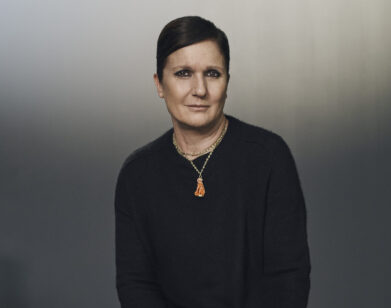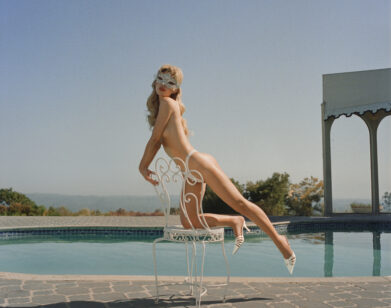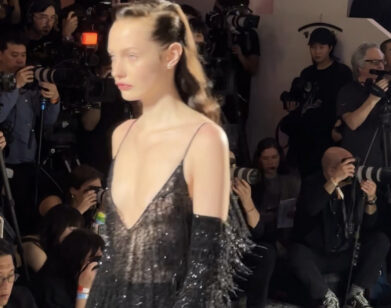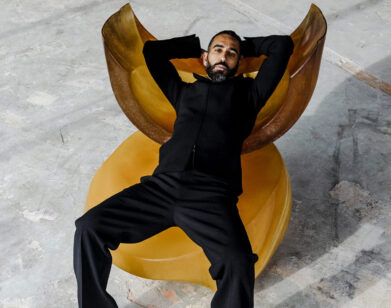The Sartorialist’s Eye on Italy
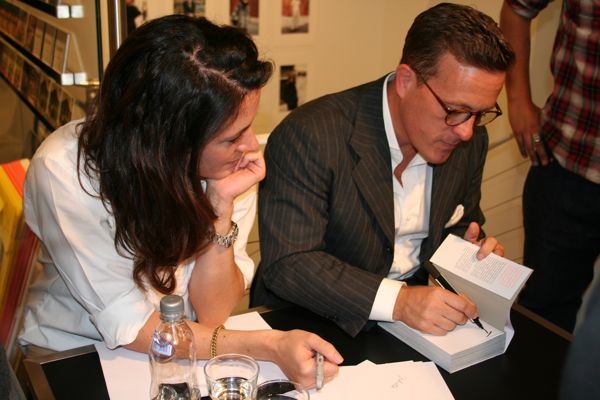
SCOTT SCHUMAN (RIGHT) WITH HIS PARTNER, GARANCE DORÉ, IN 2009.
PHOTO BY ALICE PFEIFFER
Though Scott Schuman may not consider himself a fashion editor, his blog, The Sartorialist, once a barometer of of-the-moment style, has quickly become an influence upon the looks that the roving photographer captures. When he last spoke with Interview, Schuman had just released a highly successful book of his images, and today, his photographs (and his High Priest of Fashion status) have come to be seen as the benchmark to which the crowds of copycat bloggers born in his wake aspire.
While his images occasionally convey what seems to be Schuman’s own sartorial sense (Wayfarer-esque sunglasses, camel coats), his vision is largely celebrated for his ability to locate style in a multitude of places and a variety of forms. Most recently, his “Easter in Harlem” shots demonstrate his desire to stray beyond the average fashionista’s Lower Manhattan stomping grounds, and though he’s not likely to be cruising through the Target parking lot anytime soon, Schuman consistently casts a wide net in terms of the subjects he features and the accoutrements (like a construction worker’s duct-taped boots) that catch his eye.
Arguably the most memorable characters on his site tend to be (unmistakably) Italian, from dapper men in impeccably tailored suits to gesticulating Milanese beauties to fur-cloaked elderly women toting Kelly bags. In a nod to Schuman’s eloquent take on Italian style, the FIAT Gallery, a temporary event space located at Deitch Projects’ former home, will hold an exhibition of ten of Schuman’s favorite images from his sojourns throughout the country, opening tonight and on view through Sunday.
KATIE MENDELSON: Can you tell me a little bit about your show at the FIAT gallery?
SCOTT SCHUMAN: The thing that I’m really excited about is that I did a different size of photograph this time—this time the images are 30″ by 40,” so they’re maybe like four times the size of images I’ve shown before in a gallery. I just saw them now, and once they’re in the mat and the frame, they’re just beautiful. It’s a totally different way of looking at the photographs. It’s funny because even though it’s closer to life-sized, to me anyway, they become not necessarily anymore about the person, but they almost become a little more heroic. There’s this one photograph of guy I know named Simon. The way he’s standing, the background, the way his tie’s flipping in the wind-it looks good in the small version, but in the big version, he looks like some kind of Italian fashion superhero or something. Like if the fashion police couldn’t handle it, they’d call Simon, wearing a big S on his chest for some kind of fashion superhero.
MENDELSON: They’d call him for a serious fashion emergency.
SCHUMAN: Exactly.
MENDELSON: So how did you select these pieces?
SCHUMAN: The selection part was pretty easy. I just went through and picked out some photographs of the Italians I know. Well, it wasn’t even the people, but just images I love that really have something to say about Italian style. It’s not literally about the clothes or about any particular piece, but I think in each photograph there’s a certain Italian grace. I want to say je ne sais quoi but that would be French. There’s a word actually, sprezzatura, which is an Italian word they use a lot with menswear. It just means something that’s a little intentionally fucked-up. You know, there’s a swagger. So to me, there’s just that thing, the perfection of not being so perfect. I really like these images. I was just looking at them and I really like the selection. Six guys, four girls; a mix of ages; some casual, some more tailored.
MENDELSON: You spend a lot of time in Italy, right?
SCHUMAN: Yeah. I don’t want to say “like any fashion editor”—I don’t really consider myself a fashion editor. I’m there a lot for the shows and basically any time I can figure out to get there, I go.
MENDELSON: What inspires you about Italy? What have you taken from your time there?
SCHUMAN: The reason I’m so attracted to it is the same reason that people I think are people are attracted to a Cary Grant or Fred Astaire. I think when it comes down to it, people like that, and a lot of these Italian guys I shoot are beautifully dressed in terms of the actual way they’ve put together these clothes and the ensemble and everything. But once they’re dressed, you really get the sense that they don’t really think after that. The fit is perfect, but then there’s such elegance, such a gracefulness, and I think that’s the best word for it. The English are very stiff in their clothes and very formal, that’s just their persona. There’s a very rigid formality with the English. The French always have this kind of sneer, this kind of less joyful way of wearing the clothes [laughs], a lot more black; and with the Italians, they wear the clothes with a smile, and I think that just comes through, a physical, nonverbal gracefulness that you see in their shoulders and their smile, the way they hold their hands. When you come down to the real details of what they do, that’s less important than the gesture and the grace.
MENDELSON: I see it especially in Italian men’s style. I think that it comes off as incredibly elegant, but it’s also artfully effortless. They look so natural in what they’re wearing.
SCHUMAN: But that’s where I would challenge that. Everyone’s perfect idea is this idea of effortless because then they think, oh, I could be effortless by not putting any effort into it, and maybe I’ll look great. [laughs] Where with these Italian guys, there’s no effortless. They put a lot of effort into it. But they put the effort into it the very beginning, when they’re buying it, having it tailored, altered, all that kind of stuff. That’s why I say that I think it’s the grace in which they wear the clothes. Once they put the clothes on, it’s effortless in the way they wear the clothes. There’s no formality, there’s no rigidity, at least not in the ones I shoot. It’s effortless in the way they inhabit the clothes.
MENDELSON: Looking at the new Bon Appétit made me crave a trip to Italy—the fashion, the food, the people. The country has such a presence.
SCHUMAN: It’s funny, I just saw Adam [Rapoport] this morning, and I told him the same thing. Just from flipping through really quick, I loved the pictures. He’s really chic and a cool guy, so I was expecting it to be that good.
MENDELSON: What’s your favorite place in Italy to get a meal?
SCHUMAN: Any place that’s open! No, I’m kidding. You know, to be honest, when we go out, it’s with people, and they’re usually taking me somewhere, so I’m not smart enough to remember the name. I don’t really have particular favorites and that’s what’s great about a lot of these Italian places. They’re not really hole-in-the-wall places—I think the idea of a hole in the wall is overrated—these places aren’t hole-in-the-wall, but a lot of the best places aren’t these super noticeable, showy places. I think the reason the food in Italy is so good—and it’s the same thing with the clothes—Italians really love Italian stuff. When you go to Italy, basically the only restaurants there are Italian. There are no Mexican restaurants; they’re just now getting some Japanese. I don’t know if I’ve ever been to a French restaurant there. I mean, they cook Italian food so well because that’s all they cook. They’re geniuses at it.
MENDELSON: I just watched the short film of you that Tyler Manson did, which I thought was excellent.
SCHUMAN: Thank you.
MENDELSON: There’s a moment in the film when you ask a woman to photograph her and she kind of turns her nose up at you. When she finds out what it’s for, her attitude totally changes and she completely relaxes. You’ve become incredibly well known. Has that changed your photography and what you’re doing?
SCHUMAN: I think the way it’s changed it is that it affords me the time to get the shot I want. A girl like that before, maybe she would have said no and I would have said okay and just walked away. Now it just takes a minute and if I tell them the site, they say, “Oh yeah, that’s really great.” So it doesn’t really change who I ask, but for the people that know who I am, it just gives me more time, I don’t have to shoot as quickly and they’ll be more comfortable. We can walk, maybe, for a block before I find a shot that’s just right. Before, I had to shoot it quick before they’d decide okay, that’s it, that’s all the time you get it. Now, they’re willing to give you more time and work with you a little more, are more patient if you ask them to turn a shoulder or something. They’re also more comfortable; they think, “Okay, wow, I might be able to get a really great picture here.” But that’s just in certain areas. I like the challenge of constantly going to new places, it keeps me on my toes. If I just kept rolling around where people knew my work, it would get old after a while.
MENDELSON: I’m always interested in when the camera gets turned on people that are constantly behind the camera. I think that adds a new element to the work—your gaze is now being gazed upon.
SCHUMAN: Right. That’s one of the few videos I’ve liked. This one was so beautifully filmed, and so well done. I usually keep away from stuff like that. It’s funny, the site, photographically I think, continues to become more personal. But from an actual real standpoint, I have myself in it less and less, personal things about me. When you start out, people are cheering for you until you get to a certain point and then they don’t feel very close to you anymore, and then they cheer for you but in a different way. They now feel like you’re really above them, and you now kind of have to pull back. You can’t say, “This great thing happened to me,” because people are like “Oh, okay, whatever.” I put very, very few things about myself up there. It makes it awkward to have it on me. I don’t really go after that part too much.
FIAT GALLERY IS LOCATED IN THE FORMER DEITCH PROJECTS SPACE AT 18 WOOSTER STREET IN SOHO. SCHUMAN’S EXHIBITION EXTENDS UNTIL SUNDAY.

